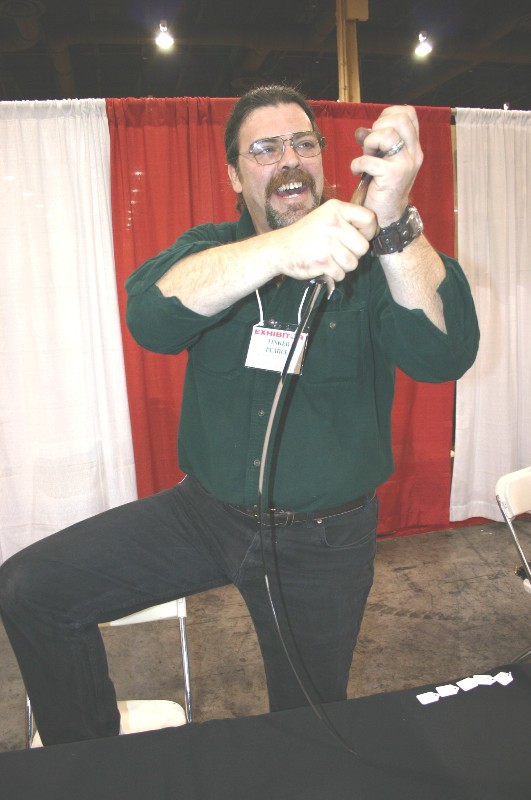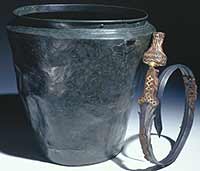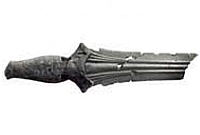| Author |
Message |
Craig Johnson
Industry Professional

|
 Posted: Thu 17 Feb, 2005 8:36 pm Post subject: Blade Flex Posted: Thu 17 Feb, 2005 8:36 pm Post subject: Blade Flex |
 |
|
Flexibility
Ahhh the old blade flex stories, a favorite chapter in the old "riddle of steel" mythology 
There is also the Elizabethan description of the rapier blade that could be rolled into the brim of a hat and extracted and used in perfect condition. Another tall tail in my estimation.
As Peter indicated, this is something to be quite wary of when you hear descriptions of full circle flexing. It is also always impossible to find someone who has actually witnessed said test. Though one would think if achieved it would make a fine picture for the smiths website. There are several hurdles that physics and metallurgy through in the accomplishment of such a feat. The ones Peter has pointed out as well as such facts as
- any minor stress riser would be apt to create a wonderful display of the blades takedown ability. The use of pattern welding in the blade increasing the possibility of said flaws probably in the magnitude of a thousand or more.
- The fact that the non-hardened iron/steel in the core of the blade would actually add drag to the flex of the steel and work against it returning to shape.
- the metallurgy of the period had a distinct variegated quality with an inconsistent carbon content through out the blade and thus a varied flexibility through out the blade. This is of course only on that portion of the blade that was able to be hardened to the point of flexing. The rest of the blade as in the above point would just bend.
Work hardening is effective for edge retention when a cutting edge is needed. This works on the principle of sliding the molecules against each other to create a stiffer molecular structure. Think of a deck of cards. Each card is fairly soft. Take the entire deck and it is stiff but blunt. If you push the deck sidewise it retains stiffness but gets thinner in total cross section, thus allowing a cutting edge with more stiffness. This is of course a bit of a simplification but the general principle is there. This cold work hardening thus deforms the molecular structure creating stress and thus a "harder" area along the edge. It does not make the material denser or reduce molecular size as some smiths have claimed. This is the process sometimes called "edge packing".
This was a very common practice through out the ancient world and was used on copper, bronze, iron and steel tolls and blades. The ability of a bronze sword to be effective is dependant on this process. The bronze swords of the ancient period were in fact a bit "harder" along the edges than the work hardened iron blades of the same period.
I to would be very, very interested in any articles or papers the researchers have produced on this information.
Best
Craig
|
|
    |
 |
Nate C.

|
 Posted: Thu 17 Feb, 2005 9:45 pm Post subject: Posted: Thu 17 Feb, 2005 9:45 pm Post subject: |
 |
|
Kirk,
Do you have any more info/pics of that sword? If so, would it warrant another thread? I love the blade on that one (although I'd prefer a straight one  ). ).
Thanks,
Nate C.
Sapere Aude
"If you are going to kill the man, at least give him a decent salute." - A. Blansitt
If they ever come up with a Swashbuckling School, I think one of the courses should be Laughing, then Jumping Off Something. --Jack Handy
|
|
  |
 |
|
Angus Trim
|
 Posted: Thu 17 Feb, 2005 11:18 pm Post subject: Posted: Thu 17 Feb, 2005 11:18 pm Post subject: |
 |
|
| Jonathon Janusz wrote: | Chris, I agree. It appears that the study of ancient European metallurgy (and the creation of the sword) walks a similar path to the study of the techniques to use the weapons created.
Every once and again stepping beyond the bounds of what is reasonable is not only useful but necessary in experimental reconstructive science. . . I just want to help make sure we all get there in one piece to see the results  |
Flexibility like that is quite possible, but its not metallurgy, its blade geometry. And I don't think it would be all that wonderful an idea to test something like that more than once.
Two of the sparring rapiers I make, one with a 42 inch blade, one with a 44 inch blade, were pulled around to within 6 inches of tip touching pommel.Both were done without my foreknowledge, in both cases I went ballistic.
At the time, both straightened back up. One of them is still in service three years later, albeit the blade is now 35 inches long. The other one took a weird set about 6 months after the flex test, and I took it back and replaced it, and destroyed it. Flexing a blade that far is stupid {major understatement}.
Now, I could make a 32 inch bladed type X that would flex that much and return to true....... But, it would be very thin in crossection, and I wouldn't really want to cut with it, if it had been flexed like that more than once. You'd start building fatigue in something like that right away.
The sword would probably be an absolutely wonderful bottle cutter, likely a decent mat cutter unless you got your edge alignment off a bit. If you did that, it likely would bend around the target. And harder targets, it would be a good idea to forget it........
Consider this an opinion, you could make a sword that could flex that much, but it wouldn't be much of a sword.
swords are fun
|
|
  |
 |
|
Scott Byler
Location: New Mexico Joined: 20 Aug 2003
Posts: 209
|
 Posted: Fri 18 Feb, 2005 12:24 am Post subject: Posted: Fri 18 Feb, 2005 12:24 am Post subject: |
 |
|
Kirk, let me echo a couple other folks and ask for any more info on that sword. Been a while, but that one has caught my interest, especially the blade. Very different... My first thought on seeing it was "hey, I wonder who could make me one of these"... 
|
|
  |
 |
Craig Johnson
Industry Professional

|
 Posted: Fri 18 Feb, 2005 5:43 am Post subject: Blade geometry Posted: Fri 18 Feb, 2005 5:43 am Post subject: Blade geometry |
 |
|
| Angus Trim wrote: |
Flexibility like that is quite possible, but its not metallurgy, its blade geometry. And I don't think it would be all that wonderful an idea to test something like that more than once.
...
Now, I could make a 32 inch bladed type X that would flex that much and return to true....... But, it would be very thin in crossection, and I wouldn't really want to cut with it, if it had been flexed like that more than once. You'd start building fatigue in something like that right away.
|
Mornin Gus
Yes I agree it is quite possible today. I agree as well that it is probably less than a good idea.
For the Hundred Thousand dollar question  Could it be done with period composite blade construction of iron and iron/steel mixes and accomplished with only work hardening? Could it be done with period composite blade construction of iron and iron/steel mixes and accomplished with only work hardening?
Put me down for the first one 
I think you have also commented on something I forgot to mention in my list. Blade geometry. The fullered type X style of blade allows the cross section of the blade to actually work against said flex. The blade in essence has two spines, this adds "stiffness" to the piece, not hardness. the edges of the fuller work against the blade having flex and allow the amount of material in such a blade to have more rigidity in the cut, a good thing, for blades that can be exceptionally light and fast.
Must go need coffee.
Best
Craig
|
|
    |
 |
|
Angus Trim
|
 Posted: Fri 18 Feb, 2005 8:53 am Post subject: Re: Blade geometry Posted: Fri 18 Feb, 2005 8:53 am Post subject: Re: Blade geometry |
 |
|
| Craig Johnson wrote: |
Mornin Gus
Yes I agree it is quite possible today. I agree as well that it is probably less than a good idea.
For the Hundred Thousand dollar question  Could it be done with period composite blade construction of iron and iron/steel mixes and accomplished with only work hardening? Could it be done with period composite blade construction of iron and iron/steel mixes and accomplished with only work hardening?
Put me down for the first one 
I think you have also commented on something I forgot to mention in my list. Blade geometry. The fullered type X style of blade allows the cross section of the blade to actually work against said flex. The blade in essence has two spines, this adds "stiffness" to the piece, not hardness. the edges of the fuller work against the blade having flex and allow the amount of material in such a blade to have more rigidity in the cut, a good thing, for blades that can be exceptionally light and fast.
Must go need coffee.
Best
Craig |
Hi Craig
I didn't address the issue of period construction, because I don't know. I do know that low carbon steel can be work hardened somewhat by hammering it, and can be made relatively flexible. I do not know if it can be made to approximate modern high carbon steel in well tempered condition. I don't believe it can......
I don't have any real opinions on the period stuff, because I don't know enough about the construction, nor the treating of it.
The type X....... Done appropriately, you're right, the twin spines add a great deal of rigidity. But......
Tinker did a concept sword just for the heck of it a few years ago. Its known today as the "Flimsy Sword of Whimsy". Very thin in crossection, and very flexible. I don't know how far its been flexed, but that's the blade geometry I would do if I was trying to prove a point. The current owner would likely pitch a fit if I grabbed it to check the flexing capability of it.......
I know its been used to cut water filled milk jugs, but I don't think it would be good on much else, nor would I be willing to try it......
swords are fun
|
|
  |
 |
Thomas McDonald
myArmoury Alumni


|
 Posted: Fri 18 Feb, 2005 9:29 am Post subject: Posted: Fri 18 Feb, 2005 9:29 am Post subject: |
 |
|
Michael "flexing" one of his sword blades at the Vegas show ! Mac
 Attachment: 82.2 KB Attachment: 82.2 KB

'Gott Bewahr Die Oprechte Schotten'
XX ANDRIA XX FARARA XX
Mac's PictureTrail
|
|
   |
 |
Kirk Lee Spencer

|
 Posted: Fri 18 Feb, 2005 9:51 am Post subject: Posted: Fri 18 Feb, 2005 9:51 am Post subject: |
 |
|
Hey Guys...
Sorry about the delay... I injured my heel playing basketball yesterday and have been in alot of pain.
The circle sword is a beautiful Halstatt piece... If I remember right it was found in the burial urn with the bones of its owner. That's the reason it had to be bent into a circle. I got the picture off of Jeroen Zuiderwijk museum pictures site.
http://membres.lycos.fr/bronzeage/
I have some more closeups and pictures of other Halstatt "top hat" pommel swords with "carp tongue" blades...
I will try to open a new thread with more pics and info in a few days.
take care.
ks
Two swords
Lit in Eden’s flame
One of iron and one of ink
To place within a bloody hand
One of God or one of man
Our souls to one of
Two eternities
|
|
  |
 |
Chris Post

|
 Posted: Fri 18 Feb, 2005 10:53 am Post subject: Posted: Fri 18 Feb, 2005 10:53 am Post subject: |
 |
|
Off topic:
The Celts consistently destroyed their swords by heating them - so the "soul" leaves the blade. The German term for such a blade is actually "entseelt", I don't know if an equivalent exists in English. The blade was then bent or even crumpled quite horribly. I believe they did that to make sure nobody else would use a sword after the original owner's departure.
What Kirk posted is the typical degree of deformation. An atypical, but authentic specimen is this:

Skeppsmannens härsmakt räddes ej väta:
blodulvar vadade väst över Panta:
fram över flodens glimmande vatten
buro de lindesköldar i land.
|
|
  |
 |
|
Anton de Vries
|
 Posted: Fri 18 Feb, 2005 11:19 am Post subject: Posted: Fri 18 Feb, 2005 11:19 am Post subject: |
 |
|
[url]http://www.siteclx.nl/rmo/index.php/do-collection/language-en/sub-eenrijkevorst
[/url]
Kirk's posting reminded me of something I saw in a museum a long time ago, so I searched a bit and found a pic and some text.
It's in a museum in Leiden, the Netherlands. Looks like it's the same sword.
 Attachment: 5.26 KB Attachment: 5.26 KB

|
|
  |
 |
Thomas Laible

|
 Posted: Sat 19 Feb, 2005 7:36 am Post subject: historical flexibility test Posted: Sat 19 Feb, 2005 7:36 am Post subject: historical flexibility test |
 |
|
I;ve found some information on a historical flexibilty test - and that one seems realistic to me.
The source is Philon of Alexandria (ca. 10-50 b. Chr.). He describes a flexibility test done with the swords of the iberian celts.
The sword is held at the handle with one hand and at the tip with another - flat above the head. Then the hands are slowly lowered down to the shoulders, so the sword bends. Than you have to bring up the hands QUICK, so the sword has to straighten very fast. This test hast to be done several times and the sword hast to straighten perfect each time.
This seems realistic to me.
Thomas
|
|
  |
 |
David McElrea

|
 Posted: Mon 21 Feb, 2005 1:07 pm Post subject: Posted: Mon 21 Feb, 2005 1:07 pm Post subject: |
 |
|
With regards to the beautiful sword posted by Kirk, I think it is "Hallstatt C". An almost identical one was found in Llyn Fawr, Wales, the main difference being it was hilted in bone instead of wood (and the Welsh example is a bit worse for where with the blade broken and the pommel lost). Beautiful, either way.
Unfortunately, I have no scanner, so I've only this rather ludicrously small pic to offer.
 Attachment: 3.5 KB Attachment: 3.5 KB

|
|
  |
 |
|
Raymond Sauvage
Location: Trondheim Joined: 22 Feb 2005
Posts: 7
|
 Posted: Tue 22 Feb, 2005 4:24 am Post subject: In reply to Einars request: Posted: Tue 22 Feb, 2005 4:24 am Post subject: In reply to Einars request: |
 |
|
As I said above, the projects ame was to examine a number of swords in norwegian and russian museums using non-destructive metodes like stereo-X-ray etc. Since a non destructive aproach was used, they where able to examine over 300 swords choosen from more than 3500 viking age swords in Norvegian museums and some from Russians. The aim was to look for inscriptions and patternwelding.
The project was ledd by Anne Stalsberg from the university of Trondheim and prof. Anatol Kirpitsnikov from the university of St. Petersburg. Also conservationsts Leena Airola and engineer/blacksmith Kasper Andresen partisipasted.
They are curently working on publishing the work which I belive will be published this year in Norvegian and Russian (for those reading only english i belive there wil only be an english abstract). The work wil contain a catalog of the swords examined.
To sumarice the results so far: Allmost all swords had inscriptions both letters, geometrical patterns and figures. Some also had Cryllian letters (Russian alfabet). There seems also to be some signs of early christian influence, lots of crosses and on one there was a crusified person. All blades was built up using rods welded together to form the blade (like patternwelding). On some the rods was twisted in different ways producing a varity of patterns (This is offvourse known on a varity of swords). But it also shown that the blades was made from rods wich did not produce patterns.
sincerly
Raymond Sauavge
stud.MA, Museum of science and archaeology, NTNU, Trondheim
|
|
  |
 |
Patrik Erik Lars Lindblom

|
 Posted: Tue 22 Feb, 2005 5:59 am Post subject: Posted: Tue 22 Feb, 2005 5:59 am Post subject: |
 |
|
Hej Å Välkommen Raymond!
I hope you let us know when that book will be released, and where to get it. 
Frid o Fröjd!
Patrik
|
|
  |
 |
|
|
You cannot post new topics in this forum
You cannot reply to topics in this forum
You cannot edit your posts in this forum
You cannot delete your posts in this forum
You cannot vote in polls in this forum
You cannot attach files in this forum
You can download files in this forum
|
All contents © Copyright 2003-2024 myArmoury.com — All rights reserved
Discussion forums powered by phpBB © The phpBB Group
Switch to the Basic Low-bandwidth Version of the forum
|

